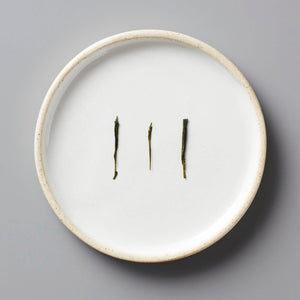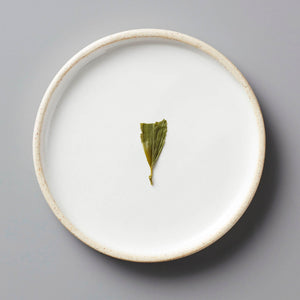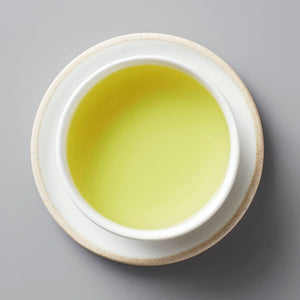Your Cart is Empty



SENCHA SEDOGAWA | green
$4.00 - $72.00
notes — daikon | grilled mackerel | fresh
This tea is certified organic.
SENCHA SEDOGAWA is an asamushi—"light steam"—sencha from Setonoya, Shizuoka, Japan. This current year, first flush production comes to us via Mukoujima tea cooperative. The tea is hand-plucked, fanned to prevent oxidation, steamed for 15 seconds, cooled, pressed, tumble-rolled, bundle-twisted, tumble-rolled again, rolled once more to needles, and finally fanned with hot air and dried to a moisture content of 4%. The result is aracha—“crude/unfinished tea” (think Japanese maocha). Just before we import the tea, it undergoes a secondary processing of pan-drying, shaping, and sorting before being vacuum-sealed and cold-stored. Mukoujima is a fully-integrated producer; all their teas are grown, processed, and packed on-site.
Also known as Happy Mukoujimaen ("en" meaning "farm"), Mukoujima has been certified organic JAS / J GAP for two decades. They operate guided by a one-with-nature tea making philosophy that prioritizes low-intervention agriculture and a low-stress environment. This is embodied by Mukoujima's signature planting style: "ippon-zitate", or, "one tree method". When cultivating new rows, they plant the smallest cuttings possible (literally a single leaf and stem), with extra space between the trees to avoid stressing them. This makes for sturdy plantings with thick, deep-reaching root structures that more adequately nourish the trees. Most Japanese plantations grow very tight rows of young trees under 30 centimeters apart; Mukoujima trees take twice as long to mature (15 years from cuttings) and grow uncrowded with a full meter between them (also making for better plucking/clipping precision at harvest). Masayuki Sonoda, our on-site liaison, embraces this spirit fully, collaborating with us on Japanese standards with new-age styling.
This is Mukoujima’s only asamushi production, and great care is taken to produce an unbroken sencha with well-formed leaves and low dust. The lot is unblended, composed 100% of the early-budding saemidori ("vivid green") cultivar, usually cultivated in the warmer climates of southern Kyushu. It's susceptible to frost (a regular event in Shizuoka). Masayuki's ippon-zitate trees, producing sturdy and hardy-growing tea, can withstand these conditions (and even benefit from the stress harsh weather brings).
Flash-steep a healthy pinch in a kyusu for white sugar sweetness and refreshing sea breeze qualities wrapped in a medium-light body with no astringency. Steep longer for that classic steamed green tea profile. Highly suitable for overnight cold brew. For all methods, use cooler water.
Scroll to the bottom for Masayuki's unabridged history of Happy Mukoujimaen:
vintage — spring '22
style — asamushi sencha
cultivar(s) — saemidori
region — Setonoya, Shizuoka, Japan
locale — Mukoujima tea cooperative
elevation — 300 meters
producer — Masayuki Sonoda
nomenclature — sencha (煎茶)—"steeped tea" | sedogawa (瀬戸川)—"Sedo river"
STEEPING PARAMETERS
(use freshly boiled spring water)
modern, large format
[300 ml+ vessel — BOLI, large teapot]
5 grams — 170°F (76°C) — 2 minutes
traditional, small format
[150 ml- vessel — kyusu, small teapot]
7 grams — 170°F (76°C) — 30 seconds (no rinse)
+30-45 seconds each additional steep
Mukoujimaen's story, as told by Masayuki-san (unedited):
Our “complete” organic cultivation was started in 1982 by an owner of past generation. He was interested in fashion field especially clothes. So he wanted to be a fashion designer sometime. However, his father forced him to be a farmer for a reason. In that time, we suffered from food shortage after WWⅡ, so we needed to grow food very efficiently in this small island. That’s why we started using agricultural chemicals and chemical fertilizers. It’s a same thing for green tea. Green tea made a lot of money so most of farmers used too much agricultural chemicals and chemical fertilizer.
Then he thought…
“This is just like me! I had a dream, but what I’m doing now is not what I wanted. These trees must have their ideal way to live. They are alive! Also, all the creatures on this planet are linked in one big circle or chain. By using agricultural chemicals and chemical fertilizer, we human beings break the chain of life in the nature.“
That’s why he started complete organic cultivation to respect the way of life of tea without any stress and to coexist with the nature forever. So our start of organic cultivation is not for food security but the respect of the tea life and coexistence with the nature. And the reason why we call it “Complete” organic cultivation is…you can call it “organic” if you are certified by certification authority like NOP or USDA in United States. However, some agricultural chemicals and fertilizers which are genetically modified are permitted to use in certain cases. We don't use. That’s why we call it “complete”. By the way, our company got the first organic certification in Japan in tea category.
And here are the characteristic cultivation techniques:
If you wanna grow same variety of tea plant, you need to use cutting because tea plant is not a kind of self-pollination, but the plant which grows from the cutting is much more weaker in terms of vitality than from the seed…that’s why we need chemical stuff to support them. In general, cutting is one stalk with two leaves and put in nursery (seed bed), which means cutting is just like to grow a clone human in incubator. Do you know a proverb “The child is father to the man”? This shows what you learn or experience in early childhood is most important and it is carried to the adult. So what he did is to put the smallest size of cutting, only a leaf, in the middle of field. What a severe environment! Also, imagine you get on the very crowded train. You must feel stressed and it’s same thing for tea plants. So he took a distance from 50cm to 1m in between. (Normally it is less than 30cm.) Normally it takes 5 to 7 years to be able to start the harvest, but it took 15 years. As a result, the stem becomes 10 times thick as normal one, and the root becomes 8 times long. Also, in terms of nutrient, Superoxide dismutase is 4 times as great as normal one, catechin is 13 times as great as normal one! We call this method “Ippon-zitate”, ippon means one tree, zitate means the way we make.
Thank you for reading our company’s story with my poor English!
Warm regards,
Masayuki



